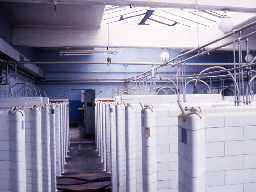Local History
Lynemouth (Northumberland)
The parish of Lynemouth lies in south-east Northumberland, on the North Sea coast. It is one of the smallest parishes in the County and until 1926 there was only a farm and cottage here. The parish is probably best known for its industrial history associated with coalmining.
There are no prehistoric, Roman or early medieval sites or finds in the parish. The township is first recorded in the 13th century but there is no evidence of a village at this time. However, aerial photographs do show that people were farming here in medieval times as small fragments of ridge and furrow survive in some pasture fields.
Lynemouth seems to have escaped the warfare that affected the border region of England in medieval times. Likewise, when unrest and fighting between border families spilled across the County in the 16th and 17th centuries, Lynemouth seems unaffected.
In the post-medieval period, a whale became beached at Lynemouth and was killed by the local blacksmith. The jawbones were used to make an archway at nearby Cresswell Hall.
Economically, the rise of Lynemouth came in the 20th century. The Ashington Coal Company bought large amounts of land here in 1900 and began building a mining village. In 1921 there had been only four houses in Lynemouth and just a few years later, when Lynemouth Colliery was established in 1927, there were 500 houses. They were followed by shops, a Miner's Welfare Institute, primary school, and a church. The church became a parish in its own right in 1961.
The colliery combined with Ellington in 1983 and meant the effective closure of Lynemouth. Today, the main employer is the nearby aluminium smelter that lies just outside the parish boundary.
There are no prehistoric, Roman or early medieval sites or finds in the parish. The township is first recorded in the 13th century but there is no evidence of a village at this time. However, aerial photographs do show that people were farming here in medieval times as small fragments of ridge and furrow survive in some pasture fields.
Lynemouth seems to have escaped the warfare that affected the border region of England in medieval times. Likewise, when unrest and fighting between border families spilled across the County in the 16th and 17th centuries, Lynemouth seems unaffected.
In the post-medieval period, a whale became beached at Lynemouth and was killed by the local blacksmith. The jawbones were used to make an archway at nearby Cresswell Hall.
Economically, the rise of Lynemouth came in the 20th century. The Ashington Coal Company bought large amounts of land here in 1900 and began building a mining village. In 1921 there had been only four houses in Lynemouth and just a few years later, when Lynemouth Colliery was established in 1927, there were 500 houses. They were followed by shops, a Miner's Welfare Institute, primary school, and a church. The church became a parish in its own right in 1961.
The colliery combined with Ellington in 1983 and meant the effective closure of Lynemouth. Today, the main employer is the nearby aluminium smelter that lies just outside the parish boundary.
N13749
UNCERTAIN
Disclaimer -
Please note that this information has been compiled from a number of different sources. Durham County Council and Northumberland County Council can accept no responsibility for any inaccuracy contained therein. If you wish to use/copy any of the images, please ensure that you read the Copyright information provided.
